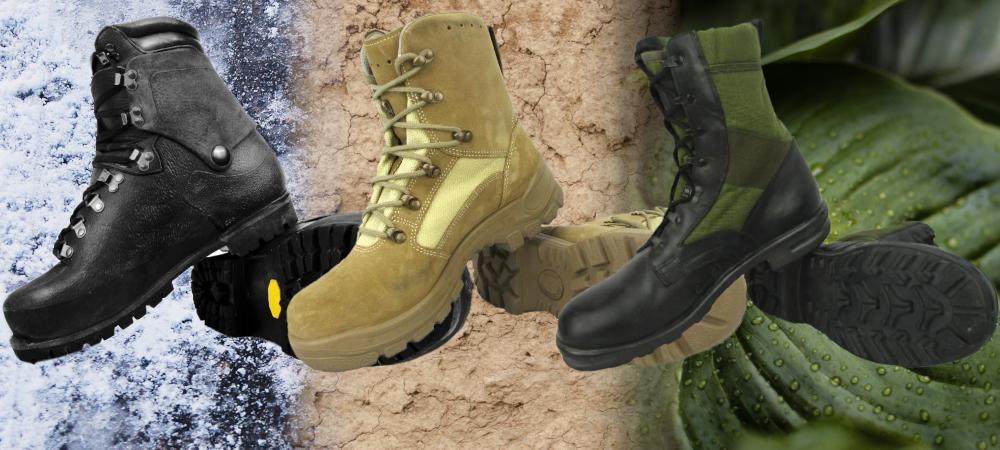Everything You Need to Know About Army Boots
People choose combat or tactical boots for a bunch of reasons. Sometimes it’s a very practical choice - they’re simply the best, most resilient boot for their needs. Sometimes it’s fashion - after all, combat boots are going to make you look pretty badass.
Whatever your reason for choosing to wear them, army boots are designed to protect the most vital part of a soldier’s body: their feet.
During real combat, if you can’t walk, you’ll die - or your mates will have to carry you, reducing the fighting capability of your section.
If you’re serious about boots, then military boots are the gear for you. You may not think they’re too different from regular hiking boots, but consider the wear and protection that a soldier’s foot might need, compared to a hiker’s, and you’ll see that they’re quite different after all.
Then and now: A (very) brief history of the army boot
You have to go way, way back to see the earliest concept of army boots.
Boots designed for combat were first introduced by the Roman army, though originally these were essentially a tall, hobnailed sandal.
The British further developed the concept in the 1600s, bringing the footwear closer to what we wear today.
Over time, combat boots have been through a whole lot of iterations, but when you really look at it, there’s a very simple reason for this. That is, with each new battle, one thing became crystal clear: your footwear can make you, or it can break you.
Today, modern combat boots incorporate the latest technology, while keeping a budget in mind. In fact, militaries offer contracts to manufacturers delivering the best quality for the lowest price.
What’s the difference between military boots and hiking boots?
Most people buy hiking boots for a specific event such as the Milford Track, or for a period of travel.
In the army, soldiers march everywhere on their feet, so army boots are not just a welcome addition to their uniform - they’re a basic necessity, and they need to be strong as all hell.
The biggest difference between hiking boots and army boots is that army boots are designed to remain intact for longer, with greater protection overall.
In fact - and weirdly - combat boots are actually the perfect boots for hiking (and hunting). They’re explicitly designed for walking through muddy terrain whilst carrying all of your equipment on your body for long, long, … long periods of time.
Do army boots make good work boots?
They’re probably not corporate attire, but there are plenty of professions where combat boots make the most appropriate footwear option.
People who work security jobs will often opt for combat boots because of the protection they offer against inebriated trouble makers.
Combat boots are also a great option for people who work outdoors in the elements, who need protective, reliable footwear that lasts.
Of course, combat boots are a no-brainer for those who work in the armed services or police force.
Basically, boots designed for the military are an excellent option for any job where there might be a risk to your feet or ankles. And hey, if your feet are safely under a desk at your nine to five, you might want to get some anyway and save them for the weekend.
Why Choose Army Boots?
Army boots are comfortable
Aside from the practical application of providing ankle support, grip and general protection for the feet, they’ve got to be hella comfortable. Feet injuries like blisters can decimate a platoon overnight, so you better believe comfort is a top consideration in the manufacturing of combat boots.
Army boots are durable
They’re durable because they need to be. There’s no love in having a pair of boots which deteriorate after one field exercise because of sweat or wet weather.
Army boots look great
Believe it or not, soldiers will complain if their gear doesn’t look good, so you don’t have to sacrifice style for utility when buying combat boots. Like we’ve said before - no matter what you’re doing - if you’re wearing combat boots, your badass meter is turned up to max.
You can get different army boots for different conditions
Combat boots must be suitable for the conditions. Most soldiers will own four or five pairs of boots depending on the length of their service. These are for the jungle (light and breathable, often canvas); desert (suede); general-purpose; or extreme cold weather (ECW), generally lined with Gore-tex.
Some manufacturers, such as Magnum (a UK company), produce boots for militaries, law enforcement, and other high-demand organisations all over the world. However, some militaries have local suppliers, such as the Redback boots used by the Australian army.
Different boots for different geographies
Boots around the world are developed for different conditions, so they’ll have different pros and cons.
European military boots
European general-purpose boots, such as those from Germany, France, Austria, and Switzerland, are based on models that were developed in the 1950s and are still used today.
They tend to be very sturdy leather with hard soles directly moulded to the boot. In many cases, they were developed for and issued to paratroopers, who had to operate in extremely harsh and varied conditions.
Around the time of World War II, the common style was with two buckles at the top. While you can still get boots like this, most have now transitioned to a fully lace-up style.
In some cases, such as with France, excess boots were put in storage around the 1990s in case of future conflict, but due to a lack of large-scale conflict in Europe, they have now been released to the market. That’s good for the rest of us!
United States military boots
In the mid-20th Century, United States boots were similar to European ones, designed for paratroopers and trenches.
However, in the 2000s, a transition began to change them for various tan-coloured boots appropriate for modern warfare in various locations, including deserts.
Modern boots are often a blend of leather, suede, and nylon.
That all sounds great - but seriously now - why are army boots so damn high?
That’s a good question, soldier.
Army boots are pretty high in the ankle. Or, we suppose, high in the calf. There are a few reasons for this:
Stability
There’s nothing much worse than having your foot slip around in (or worse, come out of) your boot when you’re in the midst of a serious situation.
A high boot gives you added stability so that you can move with confidence, and not have to concentrate on keeping your foot in your shoe. After all, you’re probably trying to focus on other things, right?
Protect those ankles
Few things would be less convenient than twisting an ankle out in the middle of nowhere, forcing your mates to carry you or immobilizing yourself. Also, little biting flies and mozzies hanging out by your foot bones? No thanks. Ankles are an annoyingly vulnerable body part when you think about it.
A high boot keeps your ankles protected from the elements and from your own clumsy self.
Everybody likes a dry foot
I mean, doesn’t this go without saying? Do you know someone who’s just itching to get their feet wet in their boots and then squelch around in them all day?
If you do, combat boots probably aren’t for that person, because the high ankle makes it much harder for water to get inside the boot.
Choose the right combat boot for you
There are a few options out there for you to browse, but we’ve actually got a few that we fancy ourselves right here.
Have a look, and feel free to contact us with any questions or if you need any advice. We don’t muck around with footwear - like we’ve said: it can make you, or it can break you!


